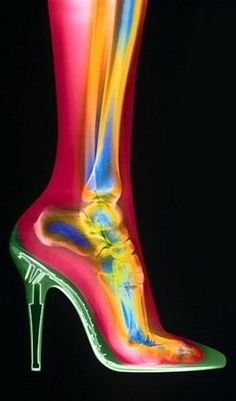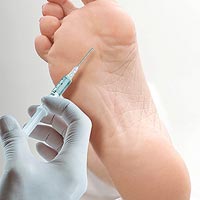The Footlift (footlift or «Loub job»)
Principle of the footlift
It is a question of managing a pathology of painful type occurring under the soles of the feet in front of the metatarsal heads. These are essentially patients wearing heels that are too high, and too often. This means that they no longer wear them, but there are often dress codes that force them to wear them. The Footlift consists in strengthening the plantar upholstery, in front of the head of the metatarsals, in order to be able to put back high heels.
The other denomination of the Footlift comes from the consequences of wearing Louboutin type high heel shoes on your feet or «Loub Job». It initially consisted of an injection of collagen or silicone. This has been done since the 1990s in the United States, with a fairly significant reduction in its safety.
The Footlift or «Loub job» derives from an extension of the plastic surgery initially used to firm the tissues or wrinkles of the face by injection of hyaluronic acid. This acid is one of the main components of the extracellular matrix, which ensures a certain arrangement of the cells between them. Footlift therefore consists of an injection of hyaluronic acid at the foot pads. The aim is to reinforce this greasy layer so that it returns to its role as a shock absorber. It counteracts orthopedic soles, which could relieve the patient in flat shoes or small heels, but which would not fit in high heels.


Theoretical principles of footlift
The weight distribution of the body between the heel and the forefoot can be estimated according to the heel height of the shoe:
- Flat: 70% of the weight on the heel and 30% on the forefoot.
- 2 cm heel: 50% on the heel and 50% on the forefoot.
- 5 cm heel: 30% on the heel and 70% on the forefoot.
- 10 cm heel and more: 90% of the weight on the forefoot (including on the head of the 2nd metatarsal).
As a result of this hypersupport, the fatty foot pad atrophies, and there is no longer a damping layer between the bone and the skin, leaving the bone “bare”. This thinning of the skin is precisely located under the head of the second metatarsal. There is no longer a»shock absorber», and the bone presses directly on the ground.
Support in consultation with the Footlift
It is proven that highly reticulated hyaluronic acid is the most effective, scientifically, in this indication. If highly reticulated hyaluronic acid is commonly used in surgery today, its absorption time, and therefore its duration of effectiveness, varies between 6 and 18 months. It also differs from hyaluronic acid used in American techniques, which is not resorbable and therefore causes complications.
The infiltration will take place after interrogation, analysis of your walk, examination of your foot prints on a podoscope, and with a ultra-sound exam.
A local anesthesia will be performed during the consultation. Then once the area is asleep, we’ll infiltrate the thinnest, most sensitive area.
You’ll walk again as soon as you leave the office, with a simple dressing to keep for 3 hours, as after a blood test. For 48 hours, you will experience some discomfort, sometimes a bruise, and you will have to wear flat shoes. You can take back the wearing of your heels, and your sports practices on the fifth day.
Over time, by punctually weighting the size of your heels, your feet will suffer less. We don’t consider it as an aesthetic act, but a real medical act to take care of your discomfort and pain. However, this act (Footlift) is not covered by social security.
If you want a Footlift, please book 1H of appointment. This corresponds to the time to get to know you, to examine you, perform the anesthesia, let it act, then carry out the infiltration of hyaluronic acid


